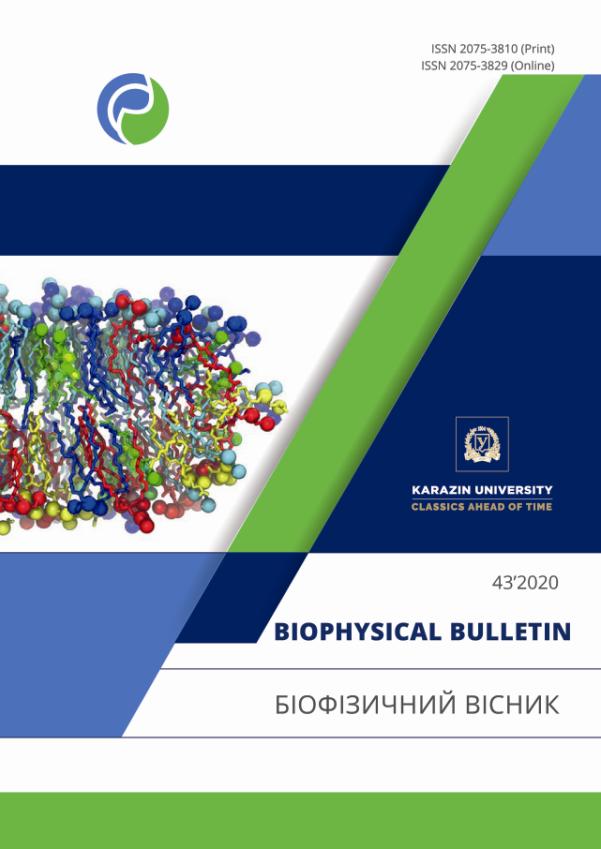Флуоресценція молекулярних композитів, що складаються з нематичного рідкого кристалу і мероціанінів
Анотація
Актуальність. Розглянуті молекули мероціаніну мають донорні та акцепторні групи з'єднані полімерним ланцюгом. Спряжені донорна D та акцепторна A частини мероціанінових молекул є планарними в основному стані. D-π-A молекулярні комплекси можуть змінювати свою конформацію в збудженому стані завдяки цис-транс-конформаційним переходам. В’язкість впливає на зміну конформації, а також на загасання фотолюмінесценції (ФЛ) та її час життя. Через це ФЛ мероціанінових молекул як в основному, так і в збудженому стані сильно залежить від середовища. Нематичний рідкий кристал був використаний як розчинник для молекул мероціаніну, оскільки він орієнтує молекули мероціаніну вздовж своєї осі та чутливий до зовнішнього електромагнітного поля. D-π-A молекулярні комплекси є перспективними для молекулярної електроніки (прилади для запису та обробки інформації), оптоелектроніки (лазерні технології), а також для біологічних досліджень (спектральні зонди на зразок відомого тіофлавіну Т) оскільки ФЛ цих молекул суттєво залежить від природи середовища.
Мета роботи. Основна мета даної роботи — дослідити та пояснити вплив рідкокристалічного середовища на розглянуті молекули. А саме: як середовище впливає на конформаційні зміни молекул та на їх спектральні властивості.
Матеріали та методи. Досліджено два типи молекул мероціаніну — М-1 та М-2. Порівнювалися спектральні властивості згаданих молекул в різних органічних розчинниках, таких як ацетонітрил, толуол, гліцерин та рідкий кристал 4-пентил-4'-ціанобіфеніл (5ЦБ). Для дослідження конформаційних змін молекул використовувались стаціонарні та часороздільні спектри випромінювання молекулярних розчинів мероціаніну. Для визначення часу життя молекулярних збуджених станів була використана методика часоскорельованого підрахунку поодиноких фотонів з пікосекундною роздільною здатністю у часі.
Результати. Результати показують, що оптичні властивості сильно залежать від конформації спряження донор-π-акцепторних сполук. У більш в’язких розчинниках збільшуються квантовий вихід і час життя ФЛ. Рідкокристалічне середовище змінює конформацію мероціанінових молекул як в основному, так і в збудженому станах.
Висновки. Аналіз результатів є підгрунтям для побудови теорії, яка пояснює властивості молекулярних D-π-A сполук після оптичного збудження. Молекули мероціаніну та рідкого кристалу утворюють молекулярні пари. Рідкокристалічна молекула визначає конформацію молекули мероціаніну в парі. Більше того, обидва типи мероціанінових молекул у рідкому кристалі мають однакову конформацію. Це припущення пояснює подібність оптичних властивостей молекул М-1 та М-2 у рідкому кристалі.
Завантаження
Посилання
Sevryukova MM, Piryatinski YuP, Vasylyuk SV, Yashchuk VM, Viniychuk OO, Gerasov AO, et al. Cyanine-like and polyenic relaxation paths of merocyanine derivatives of malonodinitrile in the excited state detecting by low temperature time-resolved fluorescence. Ukr J Phys. 2012;57(8):812–23.
Maskevich AA, Stsiapura VI, Kuzmitsky VA, Kuznetsova IM, Povarova OI, Uversky VN, et al. Spectral properties of thioflavin T in solvents with different dielectric properties and in a fibril-incorporated form. J Proteome Res. 2007;6(4):1392–401. https://doi.org/10.1021/pr0605567
Stsiapura VI, Maskevich AA, Kuzmitsky VA, Turoverov KK, Kuznetsova IM. Computational study of thioflavin T torsional relaxation in the excited state. J Phys Chem A. 2007;111(22):4829–35. https://doi.org/10.1021/jp070590o
Lisetski LN, Zavora LN, Kasian NA, Vashchenko OV, Panikarskaya VD. Cholesteric liquid crystals doped with molecules of organic scintillator materials. Mol Cryst Liq Cryst. 2009;510(1):106–15. https://doi.org/10.1080/15421400903058692
Piryatinski YuP, Sevryukova MM. Optical properties of π-conjugated donor-acceptor systems with controlled hyperpolarizability. Semiconductor Physics, Quantum Electronics and Optoelectronics. 2008;11(3):292–302.
Lemke R. Solvatochromie von 80 mμ in verschiedenen Alkoholen bei Arylidenisophoron-Abkömmlingen [80 mμ-Solvatochromy of Arylidenisophoron Derivatives in Different Alcohols]. Chemische Berichte. 1970;103(6):1894–9. [In German]. https://doi.org/10.1002/cber.19701030628
Lemke R. Knoevenagel-Kondensationen in Dimethylformamid [Knoevenagel condensations in dimethylformamide]. Synthesis. 1974;1974(5):359–61. [In German]. https://doi.org/10.1055/s-1974-23322
Sevryukova M, Piryatinski YuP. Dynamics of transfer of electron excitation in a donor-acceptor system with a carbon chain and ways of its relaxation. Semiconductor Physics Quantum Electronics and Optoelectronics. 2017 Jul;20(4):406–17. https://doi.org/10.15407/spqeo20.04.406
Fabian J, Zahradnic R. MO-LCAO calculations on polymethines. 6. PPP calculations on the vinylene shift of symmetric dyes. Wiss Z Tech Univ (Dresden). 1977;26:315–23.
Lutsyk P, Piryatinski Y, Kachkovsky O, Verbitsky A, Rozhin A. Unsymmetrical relaxation paths of the excited states in cyanine dyes detected by time-resolved fluorescence: polymethinic and polyenic forms. J Phys Chem A. 2017;121(43):8236–46. https://doi.org/10.1021/acs.jpca.7b08680
David C, Baeyens-Volant D. Absorption and fluorescence spectra of 4-cyanobiphenyl and 4-alkyl- or 4-alkoxy-substituted liquid crystalline derivatives. Mol Cryst Liq Cryst. 1980;59(3–4):181–96. https://doi.org/10.1080/00268948008071422
Piryatinskiĭ YP, Yaroshchuk OV. Photoluminescence of pentyl-cyanobiphenyl in liquid-crystal and solid-crystal states. Optics and Spectroscopy. 2000;89(6):860–6. https://doi.org/10.1134/1.1335034
Petrov VF, Grebenkin MF, Ostrovskij BIC. Issledovanie struktury nematicheskoj fazy cyanoproizvodnykh piridina metodom rasseyaniya renthenovskih luchey [Study of the structure of the nematic phase of cyanide pyridine by X-ray scattering]. Kristallografiya. 1988;33(5):1194–201.
Piryatinskiĭ YP, Yaroshchuk OV. Orientation of pentyl-cyanobiphenyl layers and variations in their luminescence spectra under UV irradiation. Optics and Spectroscopy. 2002;92(4):517–23. https://doi.org/10.1134/1.1473590
Автори, які публікуються у цьому журналі, погоджуються з наступними умовами:
- Автори залишають за собою право на авторство своєї роботи та передають журналу право першої публікації цієї роботи на умовах ліцензії Creative Commons Attribution License, котра дозволяє іншим особам вільно розповсюджувати опубліковану роботу з обов'язковим посиланням на авторів оригінальної роботи та першу публікацію роботи у цьому журналі.
- Автори мають право укладати самостійні додаткові угоди щодо неексклюзивного розповсюдження роботи у тому вигляді, в якому вона була опублікована цим журналом (наприклад, розміщувати роботу в електронному сховищі установи або публікувати у складі монографії), за умови збереження посилання на першу публікацію роботи у цьому журналі.
- Політика журналу дозволяє і заохочує розміщення авторами в мережі Інтернет (наприклад, у сховищах установ або на особистих веб-сайтах) рукопису роботи, як до подання цього рукопису до редакції, так і під час його редакційного опрацювання, оскільки це сприяє виникненню продуктивної наукової дискусії та позитивно позначається на оперативності та динаміці цитування опублікованої роботи (див. The Effect of Open Access).





